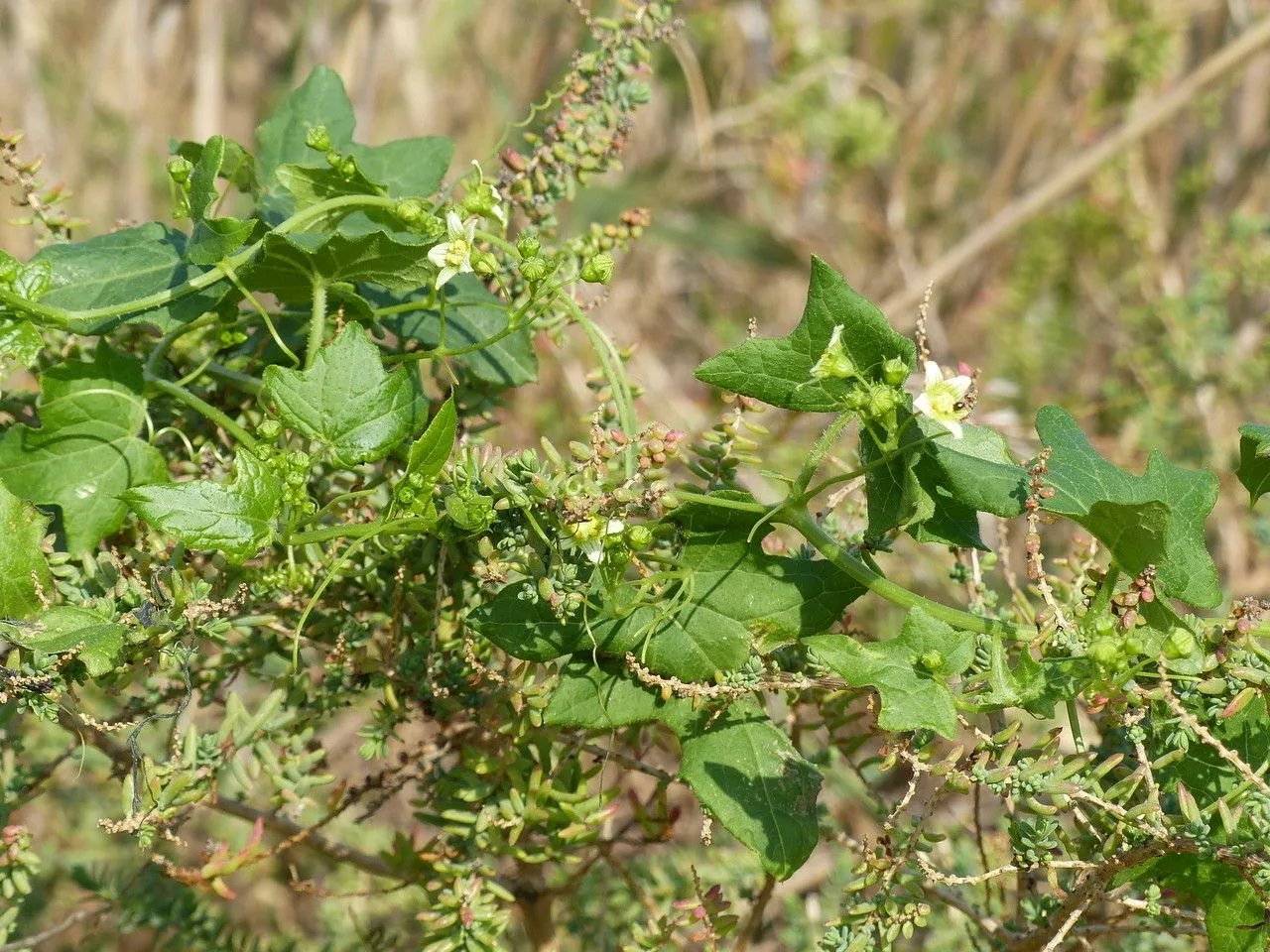
Author: L.
Bibliography: Sp. Pl.: 1012 (1753)
Year: 1753
Status: accepted
Rank: species
Genus: Bryonia
Vegetable: False
Observations: C., E. & SE. Europe to C. Asia
White bryony, scientifically known as Bryonia alba, is a perennial climbing plant belonging to the Cucurbitaceae family. It was first described in 1753 by Carl Linnaeus in his seminal work “Species Plantarum.”
Native to central, eastern, and southeastern Europe, as well as central Asia, White bryony thrives in a variety of habitats but is commonly found in hedgerows, woodlands, and areas of disturbed land. This vigorous climber uses its tendrils to grasp onto other vegetation and structures, allowing it to reach significant heights.
The plant is distinguished by its large, palmate leaves that can range from dark to light green. White bryony produces small, inconspicuous greenish-white flowers from late spring to early summer. These flowers are typically dioecious, meaning individual plants are either male or female. The fruit, which emerges in late summer, is a small, glossy berry that transitions from green to black upon maturity. Although visually striking, these berries are highly toxic and should not be consumed.
Historically, White bryony has been used in traditional medicine practices, primarily for its purported anti-inflammatory and analgesic properties. However, its use is approached with caution due to the plant’s potent toxicity. All parts of the plant, including the roots, leaves, and berries, contain bryonin, a toxic compound that can cause severe gastrointestinal distress and other health issues if ingested.
In many regions, White bryony is considered an invasive species due to its rapid growth and ability to smother native flora. Effective management often involves mechanical removal and, in some cases, the use of herbicides to control its spread.
Though its beauty and historical significance are notable, White bryony serves as a reminder of the delicate balance required in nature, highlighting the dynamic interplay between native plants and those introduced, whether intentionally or accidentally, by human activity.
Lit: baltoji brienė
Fra: bryone blanche
Dan: enbo galdebær
Eng: european white bryony, white bryony
Pol: przestęp biały
Deu: schwarzfrüchtige zaunrübe, weiße zaunrübe
Lav: balt
Est: harilik koeranaeris
Swe: hundrova, mustakoiranköynnös, svart hundrova
Fin: mustakoiranköynnös
Ces: posed bílý
Nob: svartgallebær
Nno: svartgallebær
En: White bryony, European white bryony
Hy: Լոշտակ սպիտակ
Az: Ağ küstüşam
Eu: Astamahats ale-beltz
Be: Пярэступ белы
Bg: Бяла дива тиква
Hr: Tikvina debela
Cs: Posed bílý
Da: Enbo Galdebær
Nl: White Bryony
Et: Harilik koeranaeris
Fi: Mustakoiranköynnös
Fr: Bryone blanche
De: Gichtrübe, Schwarzbeerige Zaunrübe, Schwarzfrüchtige Zaunrübe, Teufelsrübe, Weiße Zaunrübe
Ga: Unach gheal
It: Brionia bianca
Kk: Сыртыдән итжүзім
Lv: Baltā sētvija, Balt
Lt: Baltoji brienė
Mk: Дива тиква
No: Svartgallbær, Svartgallebær
Nb: Svartgallebær
Nn: Svartgallebær
Fa: بریونیا آلبا
Pl: Przestęp pospolity, Przestęp Biały
Ru: Переступень белый
Sk: Posed biely
Sv: Hundrova, Mustakoiranköynnös, Svart hundrova
Uk: Переступень білий
Taken Oct 8, 2018 by César Gonzalez (cc-by-sa)
Taken Dec 2, 2022 by Herrera Gloria (cc-by-sa)
Taken Oct 7, 2021 by Safura Obri (cc-by-sa)
Taken Jun 9, 2019 by Nathalie Tomic (cc-by-sa)
Taken Jun 9, 2017 by Ronald Kruwinus (cc-by-sa)
Taken Jun 2, 2020 by Yantchik Desprès (cc-by-sa)
Taken Oct 9, 2019 by Engin Çolak (cc-by-sa)
Taken Sep 11, 2021 by Lutz Levente (cc-by-sa)
Taken Aug 26, 2022 by Flora Striefler (cc-by-sa)
Taken Jan 31, 2021 by Manavella Leonardo (cc-by-sa)
Taken Jun 22, 2019 by Mimi (cc-by-sa)
Taken Jun 5, 2022 by pasquale pianese (cc-by-sa)
Taken Jul 26, 2021 by alain giroux (cc-by-sa)
Taken Aug 17, 2022 by juber (cc-by-sa)
Taken Sep 29, 2020 by francois tissot (cc-by-sa)
Taken Sep 22, 2019 by Pavlína Koc. (cc-by-sa)
Taken Jun 11, 2020 by Julie Dratwiak (cc-by-sa)
Taken Jun 16, 2020 by Mickael Esteves (cc-by-sa)
Taken Oct 13, 2021 by Susanne Röhm (cc-by-sa)
Taken Jun 6, 2020 by nanoue (cc-by-sa)
Taken Sep 29, 2022 by Toby Austin (cc-by-sa)
Taken Jul 16, 2022 by manumanu4691 (cc-by-sa)
Taken May 17, 2020 by r. Unter (cc-by-sa)
Taken Jul 8, 2021 by Michael d’Apice (cc-by-sa)
Taken Apr 11, 2020 by manon Feret (cc-by-sa)
Taken Jun 9, 2020 by krystal wahl (cc-by-sa)
© copyright of the Board of Trustees of the Royal Botanic Gardens, Kew.
Growth habit>: Vine, Forb/herb
Ph maximum: 7.5
Ph minimum: 7.0
Light: 6
Atmospheric humidity: 6
Soil nutriments: 6
Family: Myrtaceae Author: (F.Muell.) K.D.Hill & L.A.S.Johnson Bibliography: Telopea 6: 402 (1995) Year: 1995 Status:…
Family: Rubiaceae Author: Pierre ex A.Froehner Bibliography: Notizbl. Bot. Gart. Berlin-Dahlem 1: 237 (1897) Year:…
Family: Sapindaceae Author: Koidz. Bibliography: J. Coll. Sci. Imp. Univ. Tokyo 32(1): 38 (1911) Year:…
Family: Asteraceae Author: A.Gray Bibliography: Pacif. Railr. Rep.: 107 (1857) Year: 1857 Status: accepted Rank:…
Family: Fabaceae Author: Medik. Bibliography: Vorles. Churpfälz. Phys.-Ökon. Ges. 2: 398 (1787) Year: 1787 Status:…
Family: Aspleniaceae Author: (Cav.) Alston Bibliography: Bull. Misc. Inform. Kew 1932: 309 (1932) Year: 1932…